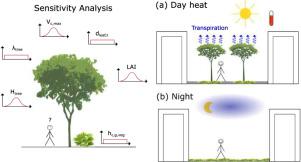Building and Environment ( IF 7.1 ) Pub Date : 2021-02-22 , DOI: 10.1016/j.buildenv.2021.107733 Naika Meili , Juan Angel Acero , Nadav Peleg , Gabriele Manoli , Paolo Burlando , Simone Fatichi

|
An increase in urban vegetation is an often proposed mitigation strategy to reduce urban heat and improve outdoor thermal comfort (OTC). Vegetation can alter urban microclimate through changes in air temperature, mean radiant temperature, humidity, and wind speed. In this study, we model how street tree and ground vegetation cover and their structural, optical, interception, and physiological traits control the diurnal cycle of OTC in different urban densities in a tropical city (Singapore). For this purpose, we perform a variance based sensitivity analysis of the urban ecohydrological model UT&C. Model performance is evaluated through a comparison with local microclimate measurements and OTC is assessed with the Universal Thermal Climate Index (UTCI).
We find a pronounced daily cycle of vegetation effects on UTCI. Tree cover fraction is more efficient in decreasing UTCI during daytime, while a higher vegetated ground fraction provides more cooling during night. Generally, increasing vegetation cover fractions do not deter OTC, except in certain urban densities during some periods of the day. An increase in tree and ground vegetation fractions provides a higher average UTCI reduction compared to a change in vegetation traits (0.9 – 2.9 °C vs. 0.7 – 1.1 °C during midday, 10 month average). The increase in humidity related to plant transpiration prevents further reduction of UTCI. However, the choice of vegetation traits enhancing tree transpiration can decrease UTCI during hot periods. These results can inform urban planners on the selection of vegetation amount and traits to achieve feasible OTC improvements in tropical cities.
中文翻译:

植被和植物性状对热带城市室外热舒适性的影响
人们通常建议增加城市植被,以减少城市热量并提高室外热舒适度(OTC)。植被可以通过改变气温,平均辐射温度,湿度和风速来改变城市的小气候。在这项研究中,我们模拟了热带城市(新加坡)中不同城市密度的路边树木和地面植被的覆盖度及其结构,光学,拦截和生理特征如何控制场外交易的昼夜周期。为此,我们对城市生态水文模型UT&C进行了基于方差的敏感性分析。通过与局部微气候测量值进行比较来评估模型性能,并使用通用热气候指数(UTCI)评估OTC。
我们发现植被对UTCI的每日周期明显。树木覆盖率在白天降低UTCI方面更为有效,而植被较高的地面覆盖率则在夜间提供更多的降温效果。通常,增加植被覆盖率并不能阻止OTC,除非一天中某些时段内某些城市密度较高。与植被特征的变化相比,树木和地面植被分数的增加提供了更高的平均UTCI降低(平均为10个月的中午时为0.9 – 2.9°C与0.7 – 1.1°C)。与植物蒸腾有关的湿度增加阻止了UTCI的进一步降低。然而,在炎热时期选择能增强树木蒸腾作用的植被特征可以降低UTCI。









































 京公网安备 11010802027423号
京公网安备 11010802027423号